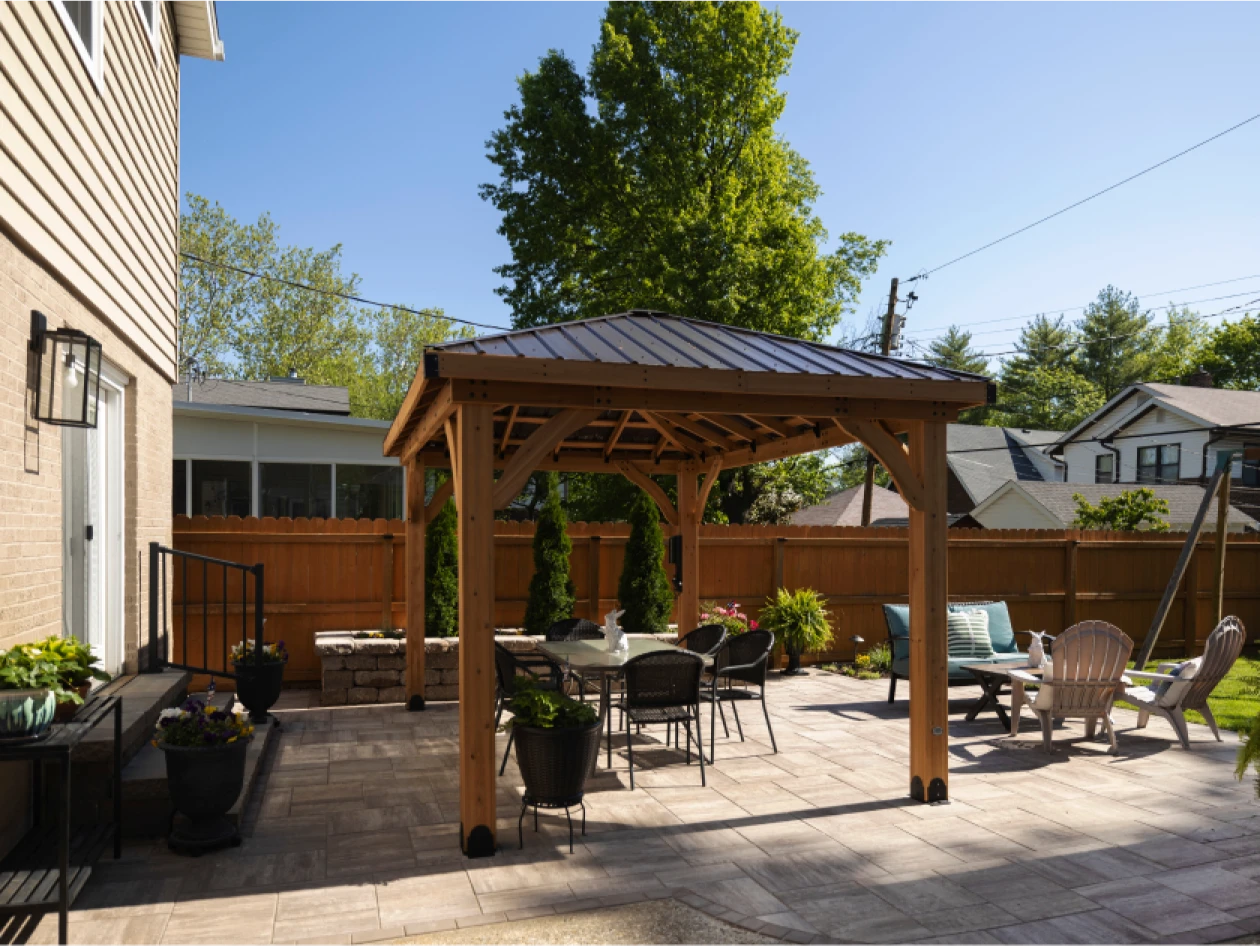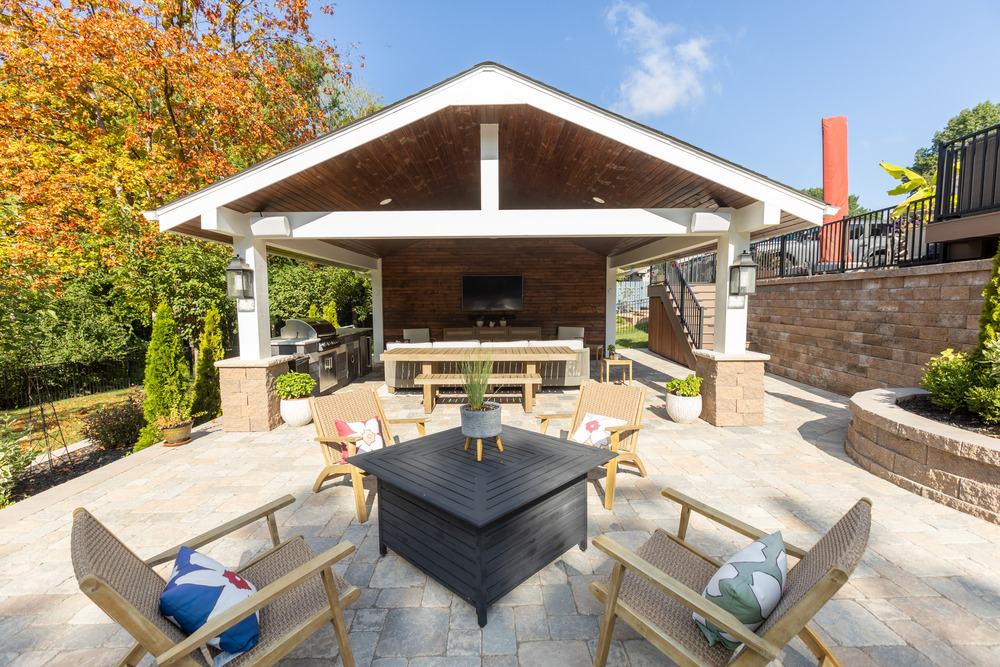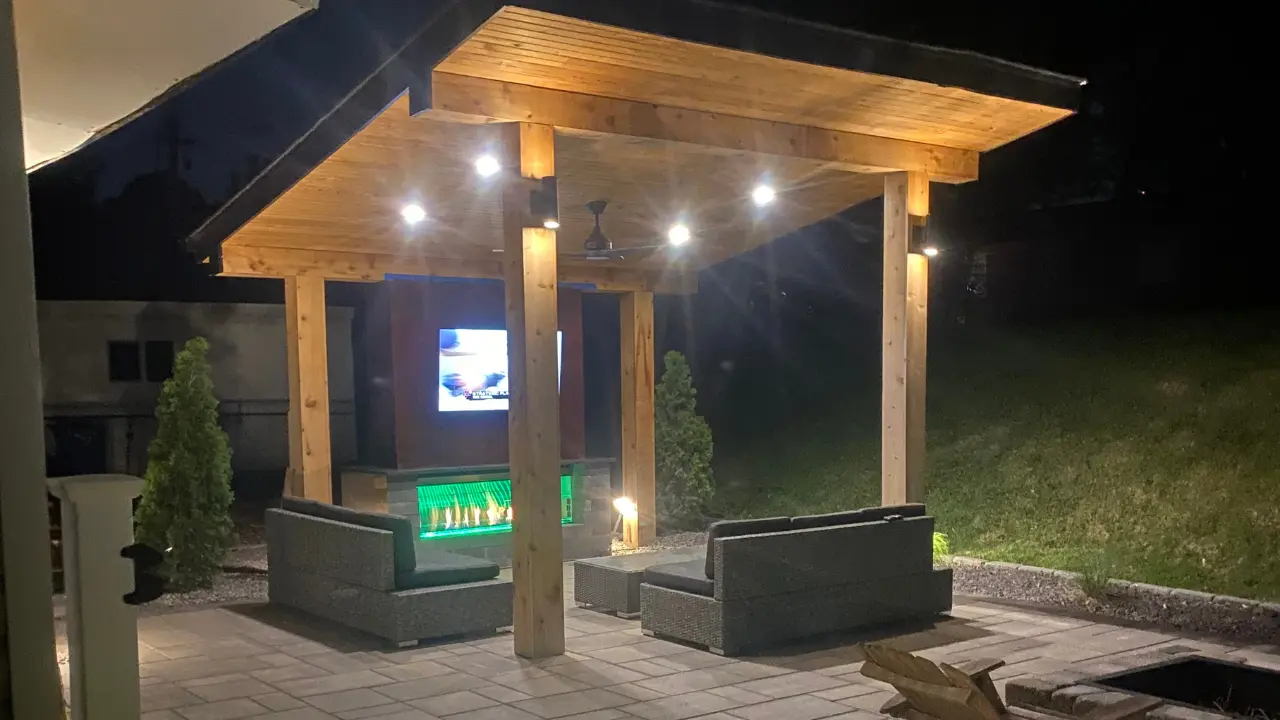Choosing the right material for your patio is one of the most important decisions when designing an outdoor space. A well-built patio enhances your home’s curb appeal, provides a place for relaxation and entertainment, and increases property value. With so many options available, selecting the perfect material can feel overwhelming. Should you go with durable pavers, affordable concrete, or timeless natural stone?
Each material has its own advantages and drawbacks, depending on your budget, maintenance preferences, and aesthetic goals. Whether you’re looking for a custom patio with intricate designs or a simple, elegant look, understanding these materials will help you make the best choice. Let’s explore the features of pavers, concrete, and natural stone to find the right fit for your patio installation project.

Finding the Right Fit: What Does Your Patio Need?
Before choosing a material, it’s essential to consider how you’ll use your patio. Do you envision a cozy gathering space for summer BBQs or a sophisticated outdoor retreat with a fire pit and seating area? The function of your patio will determine the best material for longevity and durability. If your patio will experience high foot traffic or support heavy furniture, choosing a sturdy and low-maintenance option is crucial.
Climate is another significant factor in material selection. If you live in an area with extreme temperature changes, you’ll want a patio that withstands freeze-thaw cycles without cracking. Drainage is also important, as some materials handle water better than others. For example, pavers allow water to pass through, reducing pooling, while solid concrete patios may require proper sloping.
Budget plays a role in every home improvement project, and patio design is no exception. Poured concrete is often the most affordable choice, but it may lack the character of other materials. Natural stone offers unmatched elegance but comes with a higher price tag. Pavers provide a middle ground with customizable designs at a moderate cost.
Lastly, think about long-term maintenance. Some materials require sealing, regular cleaning, or even weed control. If you prefer a low-maintenance patio, concrete might be your best bet, whereas natural stone demands more upkeep. Weighing these considerations will help you select the best option for your lifestyle and outdoor space.
Pavers: The Versatile and Durable Choice
Pavers are a favorite choice among homeowners who want a custom patio with unique designs and long-term durability. These interlocking stones come in various colors, shapes, and patterns, allowing you to create a truly personalized look. Whether you prefer a classic brick layout or a more contemporary geometric design, pavers offer endless possibilities for patio design.
One of the biggest advantages of pavers is their durability. Unlike a solid concrete patio, pavers are installed with gaps in between, allowing flexibility during temperature changes. This reduces the risk of cracking, making them an excellent choice for regions with fluctuating weather. Additionally, if a paver becomes damaged, it can be replaced individually without disturbing the entire patio.
While pavers offer impressive durability and aesthetic appeal, they do require some maintenance. Weeds can grow between the joints, and occasional resealing is necessary to maintain their color and integrity. However, with proper care, paver patios can last for decades, making them a worthwhile investment for any patio installation project.
Cost-wise, pavers fall between concrete and natural stone. While they may be more expensive than poured concrete, their longevity and ability to withstand heavy foot traffic make them a cost-effective choice in the long run. If you’re looking for an option that combines strength, beauty, and easy repairs, pavers are an excellent selection.
Concrete: Affordable, Low-Maintenance, and Stylish
For homeowners looking for a budget-friendly patio, concrete is a popular option. A concrete patio provides a smooth, seamless surface that is both functional and stylish. Modern advancements in patio design have made concrete more versatile, with options like stamped or stained concrete that mimic the look of stone or brick.
One of the key benefits of a concrete patio is its affordability. Poured concrete is generally less expensive than pavers or natural stone, making it an attractive option for homeowners who want a durable patio without breaking the bank. It’s also low-maintenance, requiring only occasional cleaning and resealing to prevent cracks and stains.
However, one drawback of concrete is its tendency to crack over time, especially in areas with extreme weather conditions. Unlike pavers, which can be individually replaced, repairing a cracked concrete patio often requires professional intervention. Proper installation, including expansion joints and sealing, can help minimize the risk of damage.
Despite its limitations, concrete remains a solid choice for many homeowners. It’s ideal for those who want a sleek, modern patio with minimal upkeep. If you’re working with a tight budget but still want a stylish outdoor space, a concrete patio might be the perfect solution.

Natural Stone: The Ultimate in Luxury and Elegance
For those seeking a truly high-end look, natural stone is the gold standard for custom patio designs. Materials like flagstone, bluestone, and limestone offer a one-of-a-kind appearance that blends seamlessly with natural landscapes. If you want a patio that exudes elegance and sophistication, natural stone is an excellent choice.
One of the most significant advantages of natural stone is its durability. It withstands harsh weather conditions and heavy use, making it ideal for long-term outdoor spaces. Unlike concrete patios, which can look uniform, natural stone patios have unique textures and colors that add character to your backyard.
However, natural stone does come with a higher price tag. It requires skilled installation, which can increase labor costs. Additionally, because stones are naturally uneven, extra care is needed when setting furniture or walking on the surface. Sealing and occasional maintenance are also necessary to preserve the stone’s beauty.
Despite the cost and maintenance, natural stone is a fantastic investment for homeowners looking to boost their home’s curb appeal and resale value. If you want a patio that makes a statement and stands the test of time, natural stone is the way to go.
Side-by-Side Comparison: Which Material is Right for You?
When comparing pavers, concrete, and natural stone, cost is often the deciding factor for many homeowners. Concrete patios are the most budget-friendly option, making them ideal for those looking for a durable yet affordable solution. Pavers fall into the mid-range price category, offering a balance between cost and customization. On the higher end, natural stone is the most expensive due to its premium look and the skilled labor required for installation. While natural stone demands a larger upfront investment, it significantly enhances property value and provides a luxurious aesthetic.
Durability is another key consideration when selecting the right patio material. Pavers are highly durable and designed to withstand heavy foot traffic and shifting ground without cracking. Concrete, while strong, is more prone to cracking over time, particularly in areas with extreme weather changes. Natural stone is the most durable of the three, capable of lasting a lifetime with proper care. However, because of its uneven surface, it may not be the best choice for families who need a completely level space for furniture or entertaining.
Maintenance needs also vary across these materials. Concrete patios require the least maintenance, needing only occasional sealing and cleaning to prevent staining and wear. Pavers require moderate maintenance, as weeds may grow between the joints and the surface may need resealing to maintain its appearance. Natural stone demands the most upkeep, as some types are porous and require frequent sealing to prevent moisture damage and staining. When choosing a material, homeowners should weigh their willingness to commit to maintenance alongside their budget and durability needs to find the best fit for their custom patio project.

FAQ Section
- Which material is the most budget-friendly?
- Concrete is typically the most affordable option, while natural stone is the most expensive.
- What’s the best material for cold climates?
- Pavers and natural stone handle freeze-thaw cycles better than poured concrete.
- Does stamped concrete last as long as pavers or stone?
- Stamped concrete can last a long time but is prone to cracking, unlike pavers or stone.
- Which patio material is easiest to repair?
- Pavers are the easiest to replace, while concrete and stone repairs are more complex.
- How often do I need to seal my patio?
- Concrete and pavers should be sealed every 2-3 years, while natural stone may require more frequent sealing.
Let the Experts Handle Your Patio Installation
No matter which material you choose, a professional outdoor living contractor ensures your patio is built to last. If you’re ready to bring your dream patio to life, Bobby K Design can help. As an expert in patio installation, they offer high-quality craftsmanship and customized solutions for your outdoor space.
Visit Bobby K Design to explore their services and start designing your perfect patio today!


